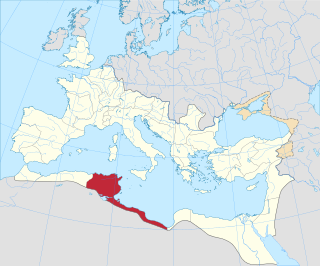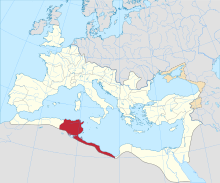
Uppenna or Upenna is a Tunisian archaeological site located on the site of the present locality of Henchir Chigarnia. The site has delivered a basilica and the remains of a fortress.

Tamazight of Djerba, Chelha of Djerba, or Djerbi is a Berber language of the Eastern Maghreb, spoken on the island of Djerba, in Tunisia. It is a component of what is regularly denominated Tunisian “Chelha” or "Shilha" in the south of the country.
Urusi was a civitas and ancient episcopal see of the Roman province of Africa Proconsularis in present-day Tunisia.

Simminensis is an ancient and titular episcopal see of the Roman province of Africa Proconsularis in modern Tunisia, and a suffragan diocese of the Archdiocese of Carthage.

Henchir-El-Hatba is a village and an archaeological site in Tunisia. It was a Roman Catholic diocese.

Vallitanus or Vallis was an ancient Roman–Berber colonia in Carthage, Tunisia. The town is identified with ruins at Sidi Medien, where are located the remains of a Roman theatre, and a number of Roman inscriptions bearing witness to the town's name, and some local officials of the time can be found near the theatre.

Abthugni was an ancient city in Roman North Africa at present day Suwar (Henchir-es-Souar) in Tunisia. It was, in Roman times, in the province of Africa Proconsularis, Africa, and latter in Byzacena. In late antiquity Abthugni was also the seat of a bishop, and the diocese is a titular see of the Roman Catholic Church to this day.

Aeliae or Æliæ was a Roman-era city in the province of Byzacena.

Sutunura was a Roman era civitas in the Roman province of Africa and is tentatively identified with ruins near Aïn-El-Askerm, Rdir-Es-Soltan in modern Tunisia.(36° 34' 29" North, 9°59'29"East) 50 km from Carthage. The location being confirmed with inscription remains in situ and is nearby to Koudiat es Somra, Jebel Barrou and Ghedir Soltane.

Dzemda is a locality in Tunisia.

Henchir-el-Kermate is a location in Tunisia and set of Roman Era ruins. The ruins are in a square shape, with perimeter of 500 meters round the enclosure. The remains of a small temple or mausoleum. There are also traces of a pont bridge, Cisterns. and several illegible inscriptions.

Henchir Bez is an archaeological site in Tunisia, located at 36° 00′ 23″ N, 9° 32 in the hills overlooking the Oued Miliane river, west of Tunis. Identified by a recently discovered inscription, it is the ruins of the Roman civitas of Vazi Sarra, which include a Christian Basilica and a Byzantine/Roman fort.

Henchir-Bel-Aït is a locality and archaeological site in Tunisia.
Crich El Oued, also known as Qarish el-Wadi, is a village in Tunisia, located between Bordj Toumi and Majaz al Bab in Béja Governorate east of Tunis. The village is on the Medjerda river at the confluence with the Oued el-Ahmar and the town has a mosque
Toukabeur is a town in Béja Governorate, Tunisia located at 36°42′32″N, 9°31′16″E. Toukabeur is in the Medjerda River valley, and 2 km west of Chaouach (Suas) and 7 kilometers northwest of Majaz al Bab,(Membressa). Its postal code is 9024.

Sululos was a Roman era Municipium of the Roman province of Africa Proconsularis that flourished from which flourished from 30 BC - AD 640. The ancient town was officially known as Municipium Septimium Aurelium Severianum Apollinare Sululitanum and is tentatively identified with ruins at Bir-el-Heuch, (Bir-el-Ach) 36.461372, 9.605158 in what is today Tunisia.
Henchir-Boucha is a former Catholic diocese and archaeological site in Tunisia.

Henchir-Aïn-Dourat, also known as Ad-Duwayrat or Henchir Durat, is a former Roman–Berber civitas and archaeological site in Tunisia. It is located at 36.767496n, 9.524142e, in the hills just north of Toukabeur and 15.3 km from Majāz al Bāb. It was an ancient Catholic diocese.

Henchir-Sidi-Salah is a rural locality and archaeological site in the hinterland behind Sfax, Tunisia.
The Henchir Guergour Neopunic inscriptions are a series of ten Neopunic inscriptions discovered by René Cagnat at Henchir Guergour, also known as Masculula, near Touiref in the Kef Governorate of Tunisia. Two of the inscriptions are known as KAI 143–144, and three are kept at the Louvre.









